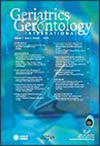Associations among frailty conditions and pain indicators: Data from 22 356 European older adults
Abstract
Aim
Recent studies supported the presence of a relationship between pain and frailty, but more research is needed to highlight the pain–frailty association. The study aimed to investigate the prevalence and the influence of different pain indicators on frailty while controlling for age, sex and country.
Methods
This observational study used data from the sixth wave of the SHARE survey. A sample of 22 356 community-dwelling individuals aged >60 years from six European countries (Spain, Estonia, France, Greece, Czech Republic and Sweden) was analyzed. The pain was measured through assessment of medication used for joint pain or other types of pain, pain location, polypharmacy and pain level. Frailty was assessed with the modified Fried Frailty phenotype.
Results
Pain indicators, especially widespread pain and pain severity, were significantly associated with prefrailty (odds ratio 3.30, 95% CI 2.40, 4.55; and odds ratio 0.61, 95% CI 0.51, 0.72) and frailty status (odds ratio 4.69, 95% CI 3.31, 6.67; and odds ratio 0.37, 95% CI 0.30, 0.44). Advancing age and female sex consistently correlated with increased prefrailty (odds ratio 1.06, 95% CI 1.05, 1.07; and odds ratio 1.36, 95% CI 1.22, 1.53) and frailty risk (odds ratio 1.11, 95% CI 1.10, 1.12; and odds ratio 1.71, 95% CI 1.48, 1.96). Country-specific differences emerged, with Spaniards showing higher odds ratios of prefrailty and frailty compared with Swedish, French and Czech individuals, whereas Greeks showed elevated odds ratios compared with Spaniards. The factors associated jointly explained 27.5% of the variance in frailty categories.
Conclusion
Significant associations were identified, particularly with widespread pain and pain severity, highlighting their impact on frailty. Country-specific variations in frailty prevalence were observed, alongside consistent associations with advancing age and female sex. These findings provide valuable insights into the intricate interplay between pain and frailty, offering the potential for targeted interventions in older adults' care through tailored pain management strategies. Geriatr Gerontol Int 2024; 24: 1362–1369.


 求助内容:
求助内容: 应助结果提醒方式:
应助结果提醒方式:


